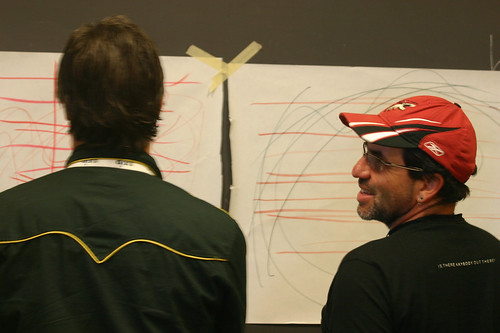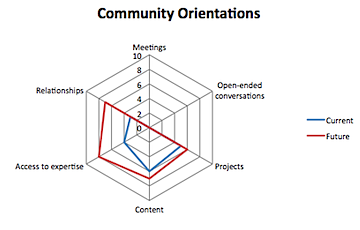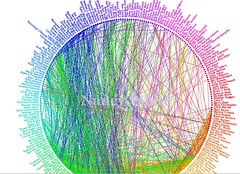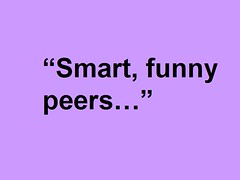I”m happy to be back for my 5th 2009 Northern Voice. We are well into the afternoon of day 1 or “moosecamp.” I’m always overwhelmed by the variety of offerings. I spent the morning in conversations, not sessions, then after lunch decided to hang out in the room where I was doing a session on Graphic Recording 101 at 2pm. That meant learning about all kinds of interesting browser plugins from the amazing Scott Leslie, then pondering on gender in blogging with Laura Blankenship and Leslie Madsen-Brooks. A half hour is a tough constraint to get to play with many plugins or begin to dive into gender issues, but both were thought provoking.
On the plugin side, I’m playing with Zemanta and Feedly. I want to check out Ubiquity and Instapaper. Alexandra Samuels turned me on to Evernote and it looks really useful for keeping track of text notes and all the flip chart images I use in work. I’ll keep you posted on these toys. I have nothing profound to share from the gender conversation other than I sense gender reveals itself in any media, but I don’t really understand it.
 Then at 2 I hosted a rapid 45 minute “Graphic recording 101” session where we jammed about 10 people on paper on the chalk board and another ten on tables to take a quick dive into the space between the pen, the paper and the wall. My SD card reader is fritzing, so I can’t upload the photos to Flickr, but I’ll get them up as soon as I can. In the meantime, here is a picture from the glorious Barbara Ganley! She, Laura and I are doing a session on “the spaces in between” tomorrow. I’ll also be graphically recording Rob Cottingham’s keynote and doing a little tech experiment with Alan Levine later in the day with his new recording/annotation toy. More on that tomorrow.
Then at 2 I hosted a rapid 45 minute “Graphic recording 101” session where we jammed about 10 people on paper on the chalk board and another ten on tables to take a quick dive into the space between the pen, the paper and the wall. My SD card reader is fritzing, so I can’t upload the photos to Flickr, but I’ll get them up as soon as I can. In the meantime, here is a picture from the glorious Barbara Ganley! She, Laura and I are doing a session on “the spaces in between” tomorrow. I’ll also be graphically recording Rob Cottingham’s keynote and doing a little tech experiment with Alan Levine later in the day with his new recording/annotation toy. More on that tomorrow.
![Reblog this post [with Zemanta]](https://img.zemanta.com/reblog_e.png?x-id=b7afbdf0-9aab-48a7-ac49-f653ac347371)
 participants of the workshop to plot on a radar chart, which I’d drawn on a whiteboard, where they thought the community was currently and then do this again for where they would like to see the community of 12 months time. It generated a terrific conversation and a feel of mutual purpose. Here is what the result looked like.
participants of the workshop to plot on a radar chart, which I’d drawn on a whiteboard, where they thought the community was currently and then do this again for where they would like to see the community of 12 months time. It generated a terrific conversation and a feel of mutual purpose. Here is what the result looked like. Ever since I was turned on to this thing called “Graphic Recording” or “
Ever since I was turned on to this thing called “Graphic Recording” or “ For the last two years I have been part of Nexus for Change. This year we decided to take a break from the work of putting on a F2F gathering and a subgroup has been preparing for some online work, this time in the form of the
For the last two years I have been part of Nexus for Change. This year we decided to take a break from the work of putting on a F2F gathering and a subgroup has been preparing for some online work, this time in the form of the 
 You can get a sense of the power of the site by visiting the site and clicking a keyword on the left. For example, if you look at the page on
You can get a sense of the power of the site by visiting the site and clicking a keyword on the left. For example, if you look at the page on  The best part of this is this is not just about my content. In fact, I’m just a drop in the bucket. I’m not alone. There is quite a network that is participating in the launch – from people who are close friends and trusted colleagues, to interesting people I try and follow.
The best part of this is this is not just about my content. In fact, I’m just a drop in the bucket. I’m not alone. There is quite a network that is participating in the launch – from people who are close friends and trusted colleagues, to interesting people I try and follow. All of this technology underneath the “hood” comes from
All of this technology underneath the “hood” comes from